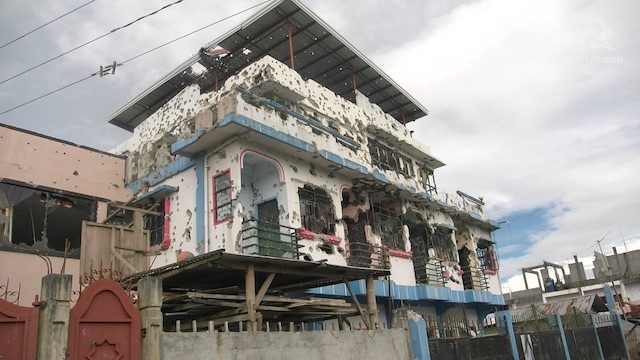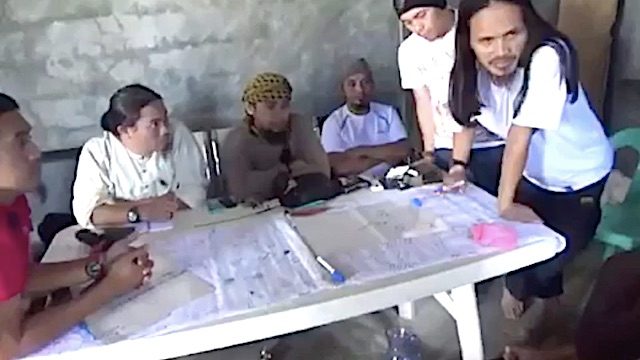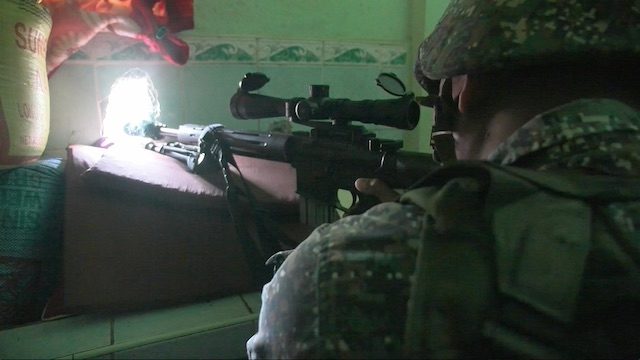SUMMARY
This is AI generated summarization, which may have errors. For context, always refer to the full article.

MARAWI CITY, Philippines – The bullet holes that riddled the freshly painted walls of the 4-storey house in the village of Basak Malutlut tell the story of an intense firefight that erupted not too far away from the military headquarters here.
This is where the war in Marawi began on May 23.
The target – Abu Sayyaf subleader Isnilon Hapilon, who was spotted in the safe house. The most wanted terrorist leader was believed to be the emir of the Islamic State (ISIS) in Southeast Asia.
The safe house in Basak Malutlut is a silent witness to the first exchange of gunfire between the military and local armed groups that sought to establish an Islamic caliphate reportedly in the name of international terrorist network ISIS. (READ: How a military raid triggered Marawi attacks)
Hapilon escaped arrest on May 23. It would take nearly 5 months of war to finally get him on October 16. A government sniper’s bullet hit him on the chest, killing him along with another terrorist leader, Omar Maute. (READ: Top Marawi siege leaders killed in clashes)
The war that started in the safe house is not over. But with the leaders gone, Armed Forces of the Philippines (AFP) chief General Eduardo Año said it will be over soon.
Most wanted
Rappler first visited the safe house in the abandoned village in June while clashes were at their height in another village, Banggolo.
It was eerily quiet in the safe house, but the military warned of danger from possible stragglers. Residents have since been allowed to return, albeit only temporarily, if only to check their properties and their belongings.
On May 23, troops were confident of the preparations they had made to get the veteran terrorist leader, who was in the most wanted list of the US Federal Bureau of Investigation at the time. He had a $5-million bounty on his head.
Hapilon led a faction of the Abu Sayyaf Group that is notorious for its kidnap-for-ransom activities in Mindanao. He’s long been the subject of a manhunt in his lairs in Basilan. (READ: What ISIS follower Isnilon Hapilon’s transcripts reveal about his childhood)
The military stepped up the manhunt when Hapilon moved to nearby Butig, Lanao del Sur, to join the highly-educated and well-connected Maute brothers, who like him pledged allegiance to ISIS. (READ: Terror in Mindanao: The Mautes of Marawi)
It turned out the military underestimated enemy strength in the neighborhood of Basak Malutlut, a mistake that would trigger the war that has ravaged the city for 4 and a half months.
“Nabigla tropa natin kasi noong gusto nila hulihin si Hapilon, kaunti lang tropa sa bahay na ‘yun. Nung lapitan ang bahay… Sa paligid, may mga armado pala,” said Defense Secretary Delfin Lorenzana.
(The troops were surprised when they wanted to arrest Hapilon, because they initially thought there weren’t too many armed men inside the house. When they moved closer to the house, it turned out there were other terrorists in the area.)
What happened after Hapilon escaped surprised the generals.
Black-clad Marawi residents carrying firearms and waving black ISIS flags rushed into the streets to attack strategic locations around the city. They occupied the Amai Pakpak Medical Center, harassed the military headquarters, released prisoners at the city jail, as well as set ablaze the Protestant-run Dansalan College and the Catholic Saint Mary’s Cathedral.
It meant the ISIS-wannabes had succeeded in recruiting a significant support base in Marawi City. The military didn’t see that coming.
Thus began one of the biggest, longest, and bloodiest operations of the Philippine military in recent history. (READ: I met a Maute soldier. He’s a child.)
The armed groups took hostages as they moved toward Banggolo, the city’s commercial district, where they held out for months.
A week after the war erupted, Brigadier General Nixon Fortes, who was then the commander of the Marawi-based 103rd Brigade, was relieved from his post.
The military initially estimated there were only 70 fighters in Marawi City. There are now nearly 800 enemies killed, based on military reports.
Propaganda video

Back in the safe house, the military recovered a video showing Hapilon and other leaders of the armed groups planning the attack. Among them was Malaysia’s most wanted terrorist Mahmud Ahmad.
“Puwede tayo mag-kuwan sa mga paaralan. Puwede tayo mag-hostage (We can target the schools. We can take hostages),” Abdullah Maute is heard saying in the video. The military believes he was killed in the firefights.
The video is supposedly propaganda material they meant to show ISIS if they succeeded in establishing a caliphate in Marawi City.
“The grand plan of this Maute-ISIS group is actually, in time for the first day of Ramadan, they will seize the whole of Marawi and proclaim an Islamic caliphate just like what happened in Mosul when [Abu Bakr] al-Baghdadi occupied Mosul in June 2014,” said Año.
But the military raid preempted a bigger terror attack, according to the AFP. “It was aborted,” said Año.
“They were not able to fully deploy all their forces, even additional forces from AKP (Ansarul Khilafah Philippines) and BIFF (Bangsamoro Islamic Freedom Fighters). Supposedly more terrorists would join, but because of what happened, when we raided the safe house on May 23, where we got also the copies of the videos, it was all aborted,” he added in a mix of English and Filipino.
Urban warfare: From the jungles to the city

Valiant Filipino soldiers used to fighting in the jungles find themselves in a terrain they are not accustomed to – urban warfare – against young radicals armed to the teeth.
Well-trained enemy snipers occupied high-rise buildings and pinned down troops who took pains to advance toward enemy positions. Troops believe the enemies were trained by foreign jihadists who joined the war.
Military armor can only do so much because the terrorists are armed with rocket-propelled grenades that can pierce through metal.
The military relied on air strikes to soften enemy position before the ground assaults. But it caused tension with residents who feared the bombs would drop on their homes or loved ones still trapped in the battle zone.
Residents pushed the government to negotiate with the terrorists as the military missed deadline after deadline. But the government rejected this.
On October 16, the hunt for Hapilon ended, but the hunt for remaining terrorists continues in the battle zone.
“It will be over sooner than you expect,” said Año.
The war has already killed more than 1,000 people and laid waste to the heart of Marawi. – Rappler.com
Add a comment
How does this make you feel?
There are no comments yet. Add your comment to start the conversation.